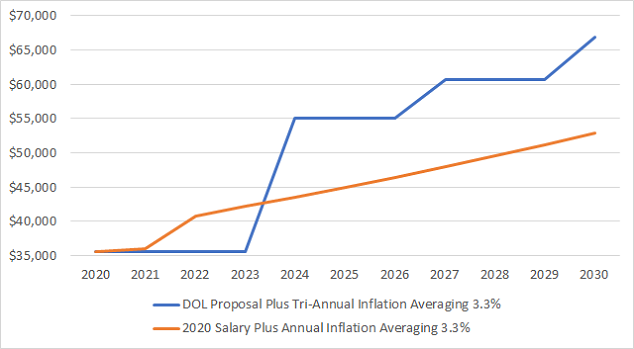Employers to Face a Choice: Raise Exempt Employees' Pay or Reclassify?
Author: Michael Cardman, XpertHR Senior Legal Editor
UPDATE - September 8, 2023: The US Department of Labor (DOL) formally published its proposed rule in the Federal Register. As a result, interested parties will be able to submit comments up until November 7, 2023.
August 30, 2023
The minimum salary for most overtime-exempt employees would go up from $35,568 per year to somewhere as high as $60,000 per year under a draft rule that the US Department of Labor (DOL) plans to release soon.
An additional 3.4 million workers who are currently exempt from the overtime requirements of the Fair Labor Standards Act (FLSA) will become eligible for overtime unless their employers raise their salaries, the DOL estimates.
The DOL also plans to increase the minimum salary for highly compensated employees from their current level of $107,432 per year. Roughly 250,000 of these workers will be affected, the DOL predicts.
Technically, the DOL intends to set the minimum salary levels to match the 35th percentile of weekly earnings of full-time nonhourly workers in the lowest-wage Census Region (currently the South) for most workers and the 85th percentile for highly compensated employees (annualized).
Based on the most recent data, those minimum salary levels currently would be $1,059 per week (or $55,068 per year) for most employees and $143,988 per year for highly compensated employees.
However, they will most likely be higher when the rule is finalized, as the DOL said it plans to use the most recent data available at that time to set the initial thresholds. In the first quarter of 2024, the DOL projects that the minimum salary level could be $1,158 per week (or $60,209 per year).
Beginning three years after the rule first takes effect, and then again every three years after that, the DOL will adjust the minimum salary levels to match the Census data. The DOL could temporarily delay a scheduled automatic update when warranted by unforeseen economic developments or other conditions.
The draft rule does not include any changes to the overtime exemptions' duties tests, which lay out the kinds of work that exempt employees must perform.
History
Changes to the FLSA minimum salary threshold are rare. When the law was first enacted in 1938, the salary threshold was set at $1,560 per year for the executive and administrative exemptions. (There was no salary threshold for the professional exemption at the time.) Since then, the salary threshold has been raised only seven times.
In 2016, the Obama administration finalized regulations that would have raised the minimum salary to $47,476 per year and then adjusted the minimum salary for inflation every three years. But eight days before those regulations were to take effect, a federal district court struck them down. It said the DOL exceeded its authority by raising the minimum salary level so high that it effectively would make the duties tests irrelevant.
In 2020, the Trump administration raised the minimum salary to its current level of $35,568 per year.
The graph below shows how the even the minimum proposed salary threshold level of $55,068 would outpace the rate of inflation if the current threshold of $35,568 per year were adjusted for inflation every year since it first took effect in 2020.
DOL Proposal vs The Rate of Inflation

(Note: the changes in 2021 and 2022 are based on the actual rate of inflation. Out years are projected based on the historic average of 3.29%.)
"While we are reviewing the impact of this proposal with our members, the proposed number is significantly higher than the rate of inflation," National Retail Federation Senior Vice President of Government Relations David French said in an email to XpertHR. "Further, the attempt to tie the hands of future administrations through automatic increases exceeds the Department's authority."
What's Next
A Notice of Proposed Rulemaking (NPRM) will soon be published in the Federal Register. Employers will have 60 days from the time the NPRM is officially published to comment. Comments may be submitted online under Regulatory Information Number (RIN) 1235-AA39 or by mailing written submissions to:
Division of Regulations, Legislation and Interpretation
Wage and Hour Division, US Department of Labor, Room S-3502
200 Constitution Avenue, N.W.
Washington, DC 20210
Written submissions must include the name of the agency and the Regulatory Information Number (RIN) 1235-AA39.
After the comment period ends, the DOL will respond to comments and possibly make revisions before publishing a final rule. This final rule will include a formal effective date no earlier than 30 days after its publication in the Federal Register. (In 2020, it was 99 days; in 2016, it was 192 days; and in 2004, it was 122 days.)
Challenges Expected
The final rule almost certainly will be challenged in the courts.
Opponents are likely to invoke the major questions doctrine, under which the Supreme Court has rejected federal agencies' regulations if they involve "vast economic and political significance" and if Congress has not clearly empowered the agency.
The tri-annual inflation adjustments may also be fertile ground for legal challenge. In 2016, the state attorneys general who successfully overturned the Obama-era overtime rule claimed among other things that automatic inflation adjustments violate federal rulemaking laws because they adjust the salary level without a notice-and-comment period.
Foes of the rule also might question whether the DOL has the authority to impose any salary minimum - let alone the proposed minimum of $55,068. During oral arguments in an FLSA case last year, Justice Brett Kavanaugh appeared open to such an argument.
The overtime rule also could be overturned by Congress under the Congressional Review Act. This is unlikely unless Republicans win either the White House or a veto-proof majority in Congress in the 2024 election and the overtime rule is finalized with fewer than 60 legislative days remaining before a new Congress is sworn in.